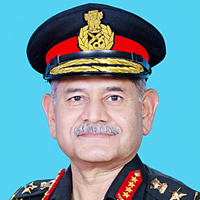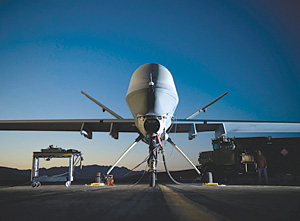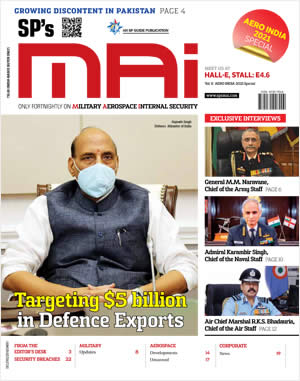INDIAN ARMED FORCES CHIEFS ON OUR RELENTLESS AND FOCUSED PUBLISHING EFFORTS

The insightful articles, inspiring narrations and analytical perspectives presented by the Editorial Team, establish an alluring connect with the reader. My compliments and best wishes to SP Guide Publications.

"Over the past 60 years, the growth of SP Guide Publications has mirrored the rising stature of Indian Navy. Its well-researched and informative magazines on Defence and Aerospace sector have served to shape an educated opinion of our military personnel, policy makers and the public alike. I wish SP's Publication team continued success, fair winds and following seas in all future endeavour!"

Since, its inception in 1964, SP Guide Publications has consistently demonstrated commitment to high-quality journalism in the aerospace and defence sectors, earning a well-deserved reputation as Asia's largest media house in this domain. I wish SP Guide Publications continued success in its pursuit of excellence.
- Indian Air Force Aims for Full Indigenous Inventory by 2047 — Air Chief Marshal A.P. Singh
- General Upendra Dwivedi takes over as the Chief of the Army Staff
- Rajnath Singh assumes charge as Defence Minister for the second consecutive term
- Admiral Dinesh K. Tripathi assumes Command of the Indian Navy as 26th Chief of the Naval Staff
- Prime Minister witnesses 'Bharat Shakti' – a Tri-Services Firing and Manoeuvre Exercise in Pokhran, Rajasthan
Drones don’t allow hit-and-run

If you use drones you must confirm and report who they killed, says legal team.
International lawyers have identified an existing but previously unacknowledged requirement in law for those who use or authorise the use of drone strikes to record and announce who has been killed and injured in each attack.
A new report, ‘Drone Attacks, International Law, and the Recording of Civilian Casualties of Armed Conflict’, is published on June 23, 2011, by London-based think tank Oxford Research Group (ORG).
Speaking at the Geneva Centre for Security Policy, Dr Susan Breau, the report’s lead author and Professor of International Law at Flinders University, said: “It is high time to implement a global casualty recording mechanism which includes civilians so that finally every casualty of every conflict is identified. The law requires it, and drones provide no exemption from that requirement.”
The key findings are:
- There is a legal requirement to identify all casualties that result from any drone use, under any and all circumstances.
- The universal human right which specifies that no-one be “arbitrarily” deprived of his or her life depends upon the identity of the deceased being established, as do reparations or compensation for possible wrongful killing, injury and other offences.
- The responsibility to properly record casualties is a requirement that extends to states who authorise or agree the use of drones, as well as those who launch and control them, but the legal (as well as moral) duty falls most heavily on the latter.
- There is a legal requirement to bury the dead according to the rites of the religion to which they belonged, and this may not be in mass or unmarked graves. The site of burial must be recorded, particularly in the event that further investigation is required.
- A particular characteristic of drone attacks is that efforts to disinter and identify the remains of the deceased may be daunting, as with any high explosive attacks on persons. However, this difficulty in no way absolves parties such as those above from their responsibility to identify all the casualties of drone attacks.
- Another characteristic of drone attacks is that as isolated strikes, rather than part of raging battles, there is no need to delay until the cessation of hostilities before taking measures to search for, collect and evacuate the dead.
Pakistan, Yemen and beyond
The report also provides a set of specific recommendations addressing the current situation in Pakistan and Yemen, where the issue of drone strikes by the United States and the recording of their casualties is of real and practical urgency. According to the report, while legal duties fall upon all the parties mentioned, it is the United States (as the launcher and controller of drones) which has least justification to shirk its responsibilities.
The implications of these findings go well beyond the particularities of these weapons, these countries, and these specific uses. The legal obligations enshrined as they are in international humanitarian law, international human rights law, and domestic law, are binding on all parties at all times in relation to any form of violent killing or injury by any party.
Elaborating on the report’s implications, Dr Breau said: “States, individually and collectively, need to plan how to work towards conformance with these substantial bodies of law. Members of civil society, particularly those that seek the welfare of the victims of conflict, have a new opportunity to press states towards fulfilling their obligations under law.”
This is not asking for the impossible. The killing of Osama bin Laden suggests the lengths to which states will go to confirm their targets when they believe this to be in their own interest. Had the political stakes in avoiding mistaken or disputed identity not been so high, Bin Laden (and whoever else was in his home) would almost certainly have been typical candidates for a drone attack.
Commenting on the report, Paul Rogers, ORG’s Consultant on Global Security and Professor at Bradford University Peace Studies Department, said: “Armed drones are fast becoming the weapons of choice by the United States and its allies in South Asia and the Middle East, yet their use raises major questions about legality which have been very largely ignored. A key and salutary finding of this report is that drone users cannot escape a legal responsibility to expose the human consequences of their attacks. This hugely important and detailed analysis addresses some of the most significant issues involved and deserves the widest coverage, not least in military, legal and political circles.”





